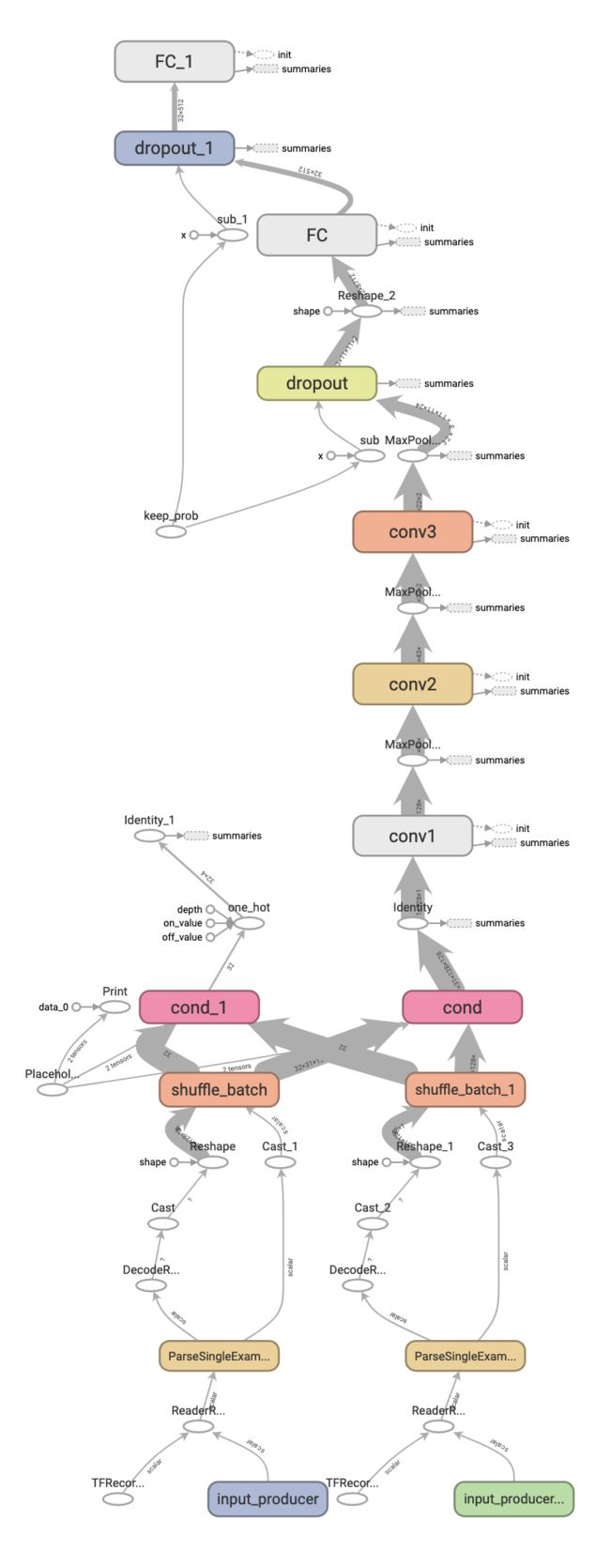LeNet3D + tfrecords 3D卷积样例 tf.nn.conv3d (立体图像卷积 3D 医疗图像卷积 (CT, fMRI))
import numpy as np
import os
os.environ["CUDA_VISIBLE_DEVICES"] = "0"
os.environ['TF_CPP_MIN_LOG_LEVEL'] = '3'
os.system("rm -r logs")
import tensorflow as tf
import matplotlib.pyplot as plt
from PIL import Image
import multiprocessing
trainPath = '../tfrecords/train.tfrecords'
testPath = '../tfrecords/test.tfrecords'
valPath = '../tfrecords/val.tfrecords'
def read_tfrecord(TFRecordPath):
with tf.Session() as sess:
feature = {
'image': tf.FixedLenFeature([], tf.string),
'label': tf.FixedLenFeature([], tf.int64),
'person': tf.FixedLenFeature([], tf.int64),
}
filename_queue = tf.train.string_input_producer([TFRecordPath])
reader = tf.TFRecordReader()
_, serialized_example = reader.read(filename_queue)
features = tf.parse_single_example(serialized_example, features = feature)
image = tf.decode_raw(features['image'], np.float64)
image = tf.cast(image, tf.float32)
image = tf.reshape(image, [31, 128, 128, 1])
label = tf.cast(features['label'], tf.int32)
return image, label
def conv3d_layer(X, k, s, channels_in, channels_out, name = 'CONV'):
with tf.name_scope(name):
W = tf.Variable(tf.truncated_normal([k, k, k, channels_in, channels_out], stddev = 0.1));
b = tf.Variable(tf.constant(0.01, shape = [channels_out]))
conv = tf.nn.conv3d(X, W, strides = [1, s, s, s, 1], padding = 'SAME')
result = tf.nn.relu(conv + b)
tf.summary.histogram('weights', W)
tf.summary.histogram('biases', b)
tf.summary.histogram('activations', result)
return result
def pool3d_layer(X, k, s, strr = 'SAME', pool_type = 'MAX'):
if pool_type == 'MAX':
result = tf.nn.max_pool3d(X,
ksize = [1, k, k, k, 1],
strides = [1, s, s, s, 1],
padding = strr)
else:
result = tf.nn.avg_pool3d(X,
ksize = [1, k, k, k, 1],
strides = [1, s, s, s, 1],
padding = strr)
return result
def fc_layer(X, neurons_in, neurons_out, last = False, name = 'FC'):
with tf.name_scope(name):
W = tf.Variable(tf.truncated_normal([neurons_in, neurons_out], stddev = 0.1))
b = tf.Variable(tf.constant(0.01, shape = [neurons_out]))
tf.summary.histogram('weights', W)
tf.summary.histogram('biases', b)
if last == False:
result = tf.nn.relu(tf.matmul(X, W) + b)
else:
result = tf.matmul(X, W) + b
tf.summary.histogram('activations', result)
return result
def Network(BatchSize, learning_rate):
tf.reset_default_graph()
with tf.Session() as sess:
is_training = tf.placeholder(dtype = tf.bool, shape=())
keep_prob = tf.placeholder('float32', name = 'keep_prob')
judge = tf.Print(is_training, ['is_training:', is_training])
image_train, label_train = read_tfrecord(trainPath)
image_val, label_val = read_tfrecord(valPath)
image_train_Batch, label_train_Batch = tf.train.shuffle_batch([image_train, label_train],
batch_size = BatchSize,
capacity = BatchSize*3 + 200,
min_after_dequeue = BatchSize)
image_val_Batch, label_val_Batch = tf.train.shuffle_batch([image_val, label_val],
batch_size = BatchSize,
capacity = BatchSize*3 + 200,
min_after_dequeue = BatchSize)
image_Batch = tf.cond(is_training, lambda: image_train_Batch, lambda: image_val_Batch)
label_Batch = tf.cond(is_training, lambda: label_train_Batch, lambda: label_val_Batch)
label_Batch = tf.one_hot(label_Batch, depth = 4)
X = tf.identity(image_Batch)
y = tf.identity(label_Batch)
conv1 = conv3d_layer(X, 3, 1, 1, 12, "conv1")
pool1 = pool3d_layer(conv1, 3, 3, "SAME", "MAX")
conv2 = conv3d_layer(pool1, 3, 1, 12, 48, 'conv2')
pool2 = pool3d_layer(conv2, 2, 2, "SAME", "MAX")
conv3 = conv3d_layer(pool2, 3, 1, 48, 24, 'conv3')
pool3 = pool3d_layer(conv3, 2, 2, "SAME", "MAX")
print(pool3.shape)
drop1 = tf.nn.dropout(pool3, keep_prob)
fc1 = fc_layer(tf.reshape(drop1, [-1, 3 * 11 * 11 * 24]), 3 * 11 * 11 * 24, 512)
drop2 = tf.nn.dropout(fc1, keep_prob)
y_result = fc_layer(drop2, 512, 4, True)
print(y_result.shape)
with tf.name_scope('summaries'):
cross_entropy = tf.reduce_mean(tf.nn.softmax_cross_entropy_with_logits(logits = y_result, labels = y))
train_step = tf.train.AdamOptimizer(learning_rate).minimize(cross_entropy)
corrent_prediction = tf.equal(tf.argmax(y, 1), tf.argmax(y_result, 1))
accuracy = tf.reduce_mean(tf.cast(corrent_prediction, 'float', name = 'accuracy'))
tf.summary.scalar("loss", cross_entropy)
tf.summary.scalar("accuracy", accuracy)
init_op = tf.group(tf.global_variables_initializer(), tf.local_variables_initializer())
sess.run(init_op)
coord = tf.train.Coordinator()
threads = tf.train.start_queue_runners(coord = coord)
merge_summary = tf.summary.merge_all()
summary__train_writer = tf.summary.FileWriter("./logs/train" + '_rate:' + str(learning_rate), sess.graph)
summary_val_writer = tf.summary.FileWriter("./logs/test" + '_rate:' + str(learning_rate))
try:
batch_index = 0
while not coord.should_stop():
sess.run([train_step], feed_dict = {keep_prob: 0.5, is_training: True})
if batch_index % 10 == 0:
summary_train, _, acc_train, loss_train = sess.run([merge_summary, train_step, accuracy, cross_entropy], feed_dict = {keep_prob: 1.0, is_training: True})
summary__train_writer.add_summary(summary_train, batch_index)
print(str(batch_index) + ' train:' + ' ' + str(acc_train) + ' ' + str(loss_train))
summary_val, acc_val, loss_val = sess.run([merge_summary, accuracy, cross_entropy], feed_dict = {keep_prob: 1.0, is_training: False})
summary_val_writer.add_summary(summary_val, batch_index)
print(str(batch_index) + ' val: ' + ' ' + str(acc_val) + ' ' + str(loss_val))
batch_index += 1;
if batch_index > 3000:
break
except tf.errors.OutOfRangeError:
print("OutofRangeError!")
finally:
print("Finish")
coord.request_stop()
coord.join(threads)
sess.close()
def main():
for rate in (0.003, 0.001):
try:
Network(32, rate)
except KeyboardInterrupt:
pass
if __name__ == '__main__':
main()



